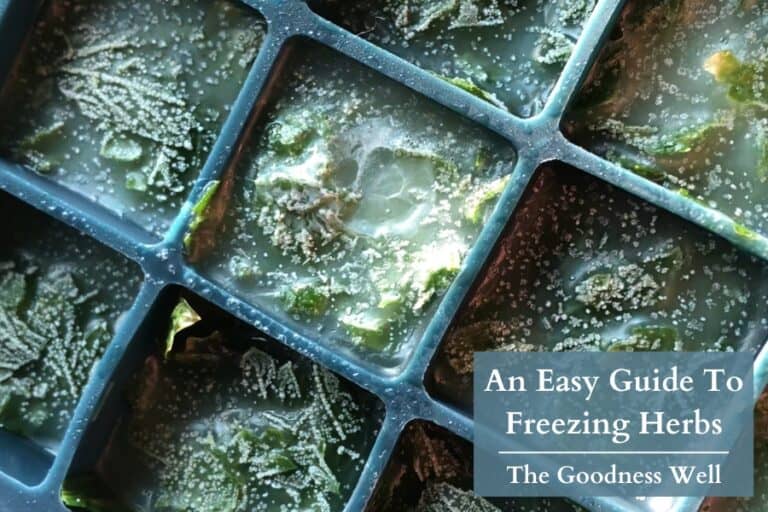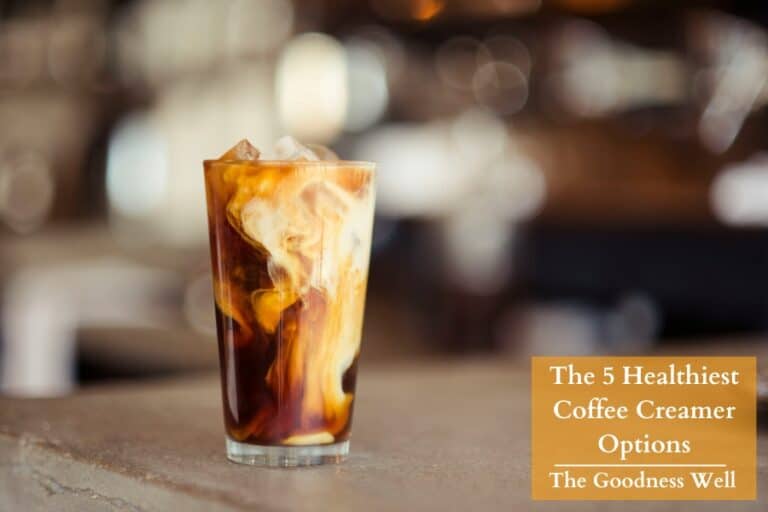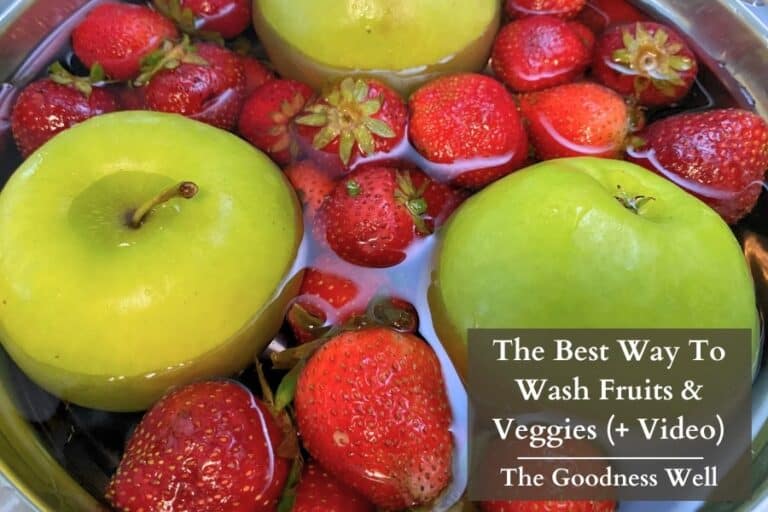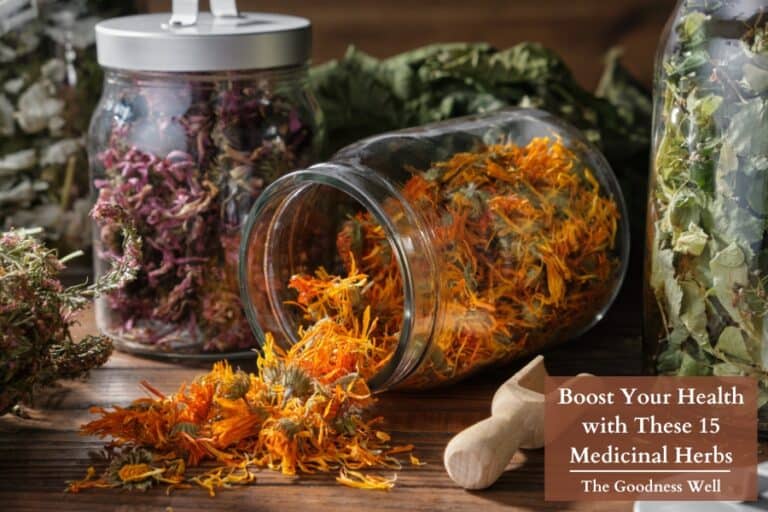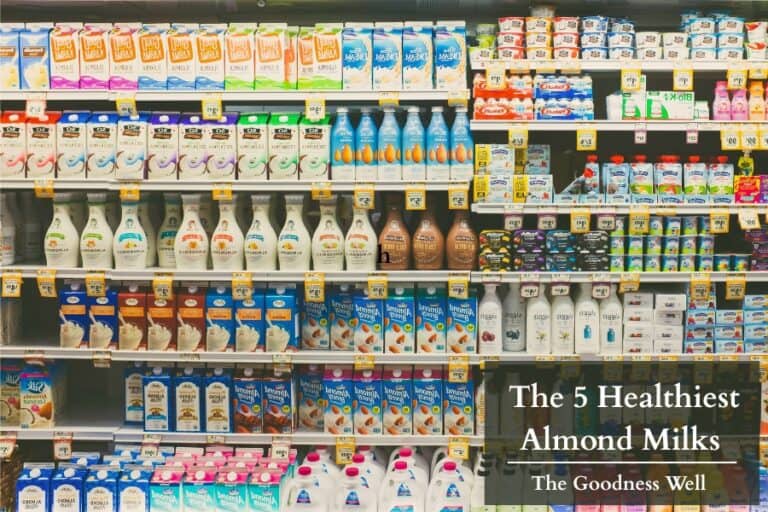How to Read a Food Ingredient Label for Dummies in 2025 (+ PDF)

Looking through food labels can feel much more confusing than it needs to be, especially when food companies try to make less healthy options appear better than they are.
As someone pursuing a Master’s in Public Health with a focus on nutrition, I’m here to help clear up the confusion.
In this guide, we break down the whole nutrition label to give you the basics, expose common misleading health claims, and arm you with the knowledge to make smarter, healthier choices.
By the end, you’ll be able to know exactly what it is you are putting in your body.
Let’s dive in!
Understanding The Basics
To understand a nutrition label, it’s important to first understand the basics of reading one.
Serving Size & Calorie Count

You will usually find the serving size at the top of the nutrition label.
And don’t skip the serving size! Because if the serving size is way off from how much you actually eat, all the other numbers are going to be meaningless.
Be sure to compare the serving size to how much you will actually eat to get an accurate view of what you’re putting in your body
Food companies love to manipulate the serving sizes of foods to make you believe what you’re eating is healthier than it is.


For instance, this mountain trail mix is already high at 13g of sugar. However, that is only in a 1/4 cup of a serving. If you’re like me, you could eat close to half the bag 😬.
Next up is the calorie count which is pretty straightforward- the higher the number, the more energy (or calories) are contained in the food.
However don’t just look at the calories, as these break down into fats, carbs, and protein, which is where the real nutrition story lies.
The Big Three: Fats, Carbs, and Protein
Let’s break these down one by one.
Protein
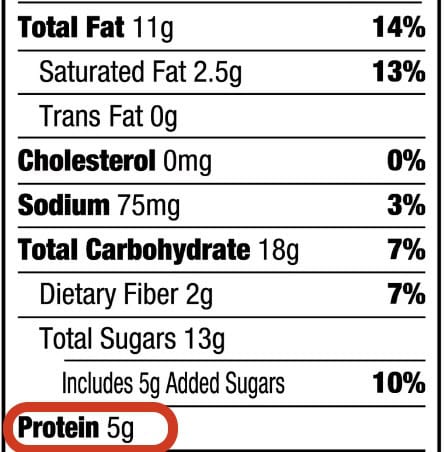
Protein is basically the building block of muscle, which is vital to maintaining a strong, healthy body. High protein foods include meats, fish, eggs, legumes, nuts, and dairy products.

You”ll see that protein is always listed as a single number without any further breakdown. This is because protein is basically one unified nutrient in regards to its amount per serving.
Carbohydrates
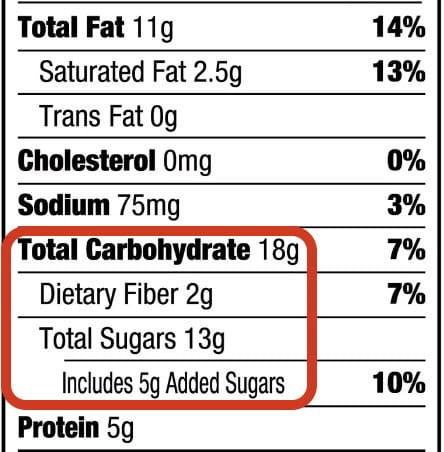
Carbohydrates (AKA carbs) are sugars and starches that your body uses as a main fuel source. They are in most foods but are higher in items like bread, pasta, rice, potatoes, and sugary snacks.
You will see the total amount of carbohydrates (18g in this example) but this is also broken down into subcategories to give you more insight into the types of carbs present and the quality of those carbs.
The main subcategories you will see are dietary fiber and sugars.

Dietary fiber is a type of carbohydrate that your body can’t fully digest and this helps with digestion and keeps you feeling full, which you can actually subtract from the total amount of carbohydrates.
Using the trail mix as an example, it actually only contains a total of 16 digestible carbs, since 2 of those carbs are fiber.
Sugars, on the other hand, can be naturally occurring or added (which we want less of), and they provide quick energy.
Fat
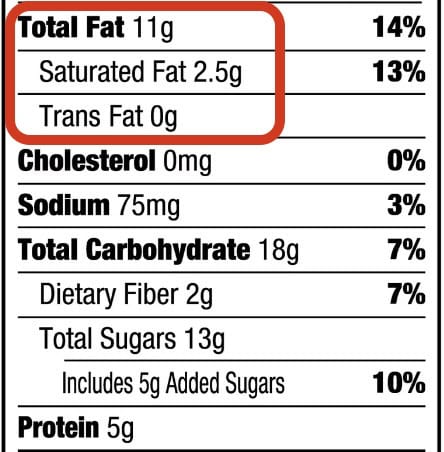
Fat is a nutrient that supports vital body functions and stores energy, found in high amounts in foods like dairy, oils, nuts, and meats.
Now for fats, you’ll usually see total fat followed by specific types like saturated fats and trans fats.
These subcategories of fat (saturated and trans) are to help you understand the quality of fats in your food.

Contrary to popular belief, saturated fats aren’t as unhealthy as once thought.
However, it’s important to get them from quality sources. Trans fats on the other hand, are indeed bad for your health, increasing the risk of metabolic diseases like stroke, heart disease, and diabetes.
You might also see monounsaturated and polyunsaturated fats listed sometimes, which are healthier fats found in foods like nuts, seeds, and fish.
Sodium & Cholesterol
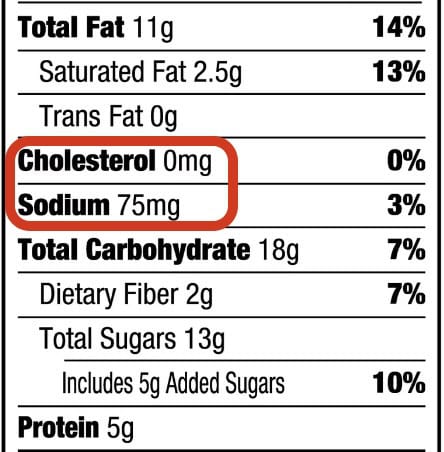
Cholesterol is a substance made by your body, and you also get some from animal products like meat, dairy, and eggs. Plant-based foods contain no cholesterol.
The American Heart Association recommends keeping cholesterol intake under 300 mg per day.
Now our bodies use proteins called LDL and HDL to transport cholesterol.
LDL (low-density lipoprotein) carries cholesterol to artery walls, which can lead to buildup and increase heart disease risk—this is why too much LDL isn’t good.
HDL (high-density lipoprotein), on the other hand, carries cholesterol to the liver for removal, which is good!
Factors like lack of exercise, trans fats, and too much saturated fat can raise LDL (not good), while exercise, a diet rich in unsaturated fats, and not smoking can raise HDL levels (good).

Sodium is basically the amount of salt in your food. While sodium is important for many bodily functions, too much can lead to health problems.
Many packaged food has very high amounts of sodium and it’s a good idea to limit it wherever possible.
Ok, now that we’ve got the basics down, let’s look at arguably the more important section, the almighty ingredient list.
The Ingredient List
I know many of these ingredients can feel like a foreign language but we’ll focus on the most important things to understand.
Ingredient Amount
First, it’s important to understand that the ingredients are listed in descending order by weight, meaning the ingredient the most abundant in the food is listed first and the one that weighs the least in the product is listed last.
Don’t be misled by this order though, as ingredients in small amounts can still have a big impact on our health.
We’ll continue with the trail mix example from above
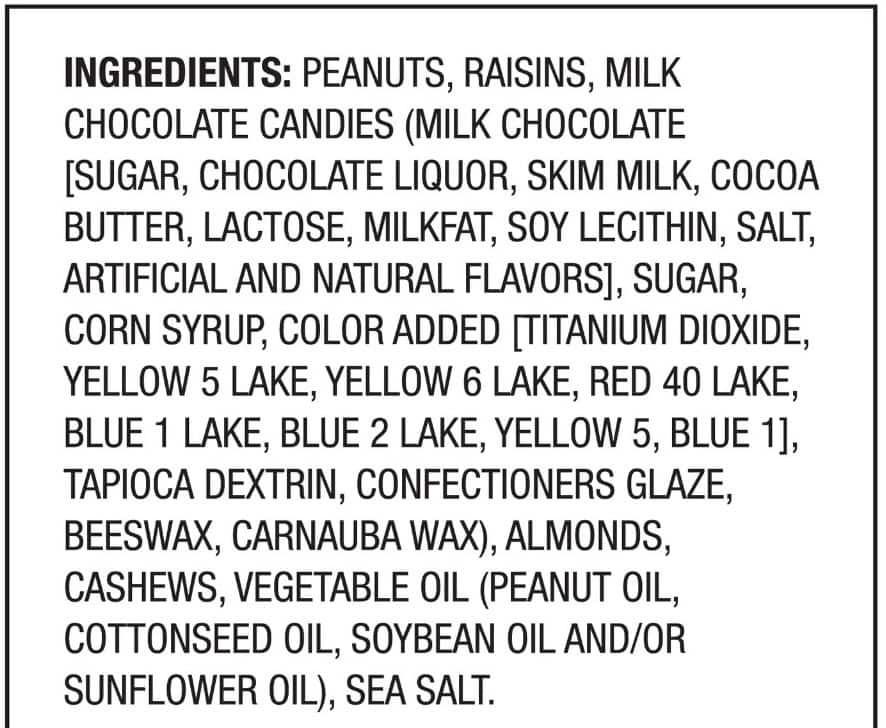
So in this list, peanuts are listed first, meaning it is the most abundant ingredient in this trail mix.
However, if you look a little farther down the list, there are added sugars like corn syrup and color additives like Red 40 Lake and Yellow 5 Lake (color additives that have been strongly linked to ADHD in children).
So even though these ingredients are lower on the list and present in small amounts, they can still contribute to health issues.
Recognizing Artificial Preservatives, Colors, and Flavors
Unhealthy foods with longer lists of ingredients usually have at least one of these, if not all three.
Preservatives
Preservatives are added to extend the shelf life of food so it doesn’t go bad.
While they can keep food safer, many preservatives are synthetic chemicals linked to adverse health effects including cancer.

Here are the most common ones along with where they are found:
- Sodium Bonzoate: Sodas, fruit juices, pickles, salad dressings, jams, condiments, cosmetics,
- Sodium Nitrite: Processed meats (bacon, ham, sausages, hot dogs, deli meats, smoked fish)
- Sulfites: Dried fruits, wines, bottled lemon/lime juices, pickled foods, canned vegetables, baked goods
- Butylated hydroxyanisole (BHA): Cereals, snack foods (potato chips), chewing gum, butter, baked goods, processed meats
- Potassium Bromate: Bread, rolls, buns, baked goods (banned in many countries, but not the US)
However, there are many safe preservatives used as well including:
- Salt
- Vinegar
- Lemon Juice
- Sugar
- Honey
- Rosemary Extract
- Vitamin E (Tocopherol)
- Citric Acid
- Grapefruit Seed Extract
- Ascorbic Acid (Vitamin C)
Colors

Artificial colors are used to enhance foods’ appearance, but many of these synthetic dyes have been linked to health issues including ADHD in children as I mentioned earlier.
The most common artificial dyes are:
- Red 40
- Yellow 5
- Yellow 6
- Blue 1 and 2
- Green 3
- Caramel Coloring
Look for natural dyes such as:
- Beet Juice
- Turmeric
- Annatto
- Paprika Spirulina
- etc.
Flavors

Flavor enhancers are VERY commonly used in foods today to make foods taste better. Here are the most common:
- Monosodium Glutamate (MSG)
- Yeast Extract
- Hydrolyzed Vegetable Protein (HVP)
- Autolyzed Yeast
- Disodium Inosinate
- Disodium Guanylate
- Soy Sauce
- Maltodextrin
- Natural Flavors
- Artificial Flavors
While these are called “flavor enhancers”, don’t let this sugar-coated label fool you.
These ingredients have been very carefully crafted by food companies to keep you coming back for more.
And “natural flavors” are no different.


While these do come from natural sources like plants, animals, or even yeast, they are usually heavily processed, contain a wide range of substances including synthetic chemicals, and might not be healthy as manufacturers are not required to disclose exactly what the natural flavor actually is.
*Tip- Artificial flavors and sugars are notorious for hiding in your coffee creamer. Here are some healthier creamer alternatives.
Identifying Allergens and Sensitivities
Safety regulations require food manufacturers to highlight common allergies below the ingredient list to alert consumers who might have allergies/sensitivities to these certain foods such as peanuts, wheat, eggs, etc.

If you have any food allergies or sensitivities, be sure to pay attention to this section when purchasing any food.
Not All Sugar is The Same
Sugar gets an extra section of explanation for here, and for good reason. It’s one of the biggest driving factors behind inflammation in our society.
It is important to know that the sugar amount listed in the nutrition facts does not tell the whole story.
Different sugars used affect your blood sugar levels differently.

For example, brown rice syrup (a type of sugar used in many “healthy” products) has a glycemic index of around 100, meaning it can spike your blood sugar quicker and higher than regular table sugar (which has a glycemic index of 65).
Foods that contain high GI-sugars can lead to spikes and crashes in blood sugar which make you feel tired and hungry soon after eating. This can lead to overeating and weight gain while increasing your risk for conditions like diabetes.
High fructose corn syrup, maltose, dextrose, and brown rice syrup can all contribute to rapid increases in blood sugar, which can also be a big issue for those with conditions like diabetes.
This is why it’s important not only to be aware of the total sugar content but also to recognize the types of sugar present in the ingredient list.
Navigating Health Claims
As if understanding nutrition labels wasn’t hard enough, food manufacturers make it even more difficult to know what’s actually healthy with the many deceiving health claims placed on their packaging.
First, lets discuss three big commonly recognized but misunderstood terms: Organic, natural, and Non-GMO
Organic, Natural, and Non-GMO
Organic

What It Means: Foods labeled “organic” must be grown without the use of synthetic pesticides, fertilizers, or genetically modified organisms (GMOs), according to standards set by the USDA.
For animal products, organic means these animals were not given antibiotics or growth hormones.
If you’re curious about understanding other terms on meat labels like grass-fed, pasture-raised, etc, check out our in-depth guide to meat labels explained.
What to Know: While organic foods are generally considered healthier due to limited chemical residues, organic does not always mean healthy. Here are a couple of examples:


Natural
What It Means: This term is probably the most widely thrown around and misused term in the food industry. “Natural” has no strict definition or regulation by the FDA, meaning it can be slapped onto pretty product regardless of the ingredients or processing methods.
What to Know: A product labeled “natural” might still contain processed ingredients, added sugars, or even preservatives, so it’s crucial to check the ingredient list rather than relying on the label.
For example:


Non-GMO
What It Means: “Non-GMO” means that the food does not contain genetically modified organisms. This claim is regulated and verified through the Non-GMO Project or similar certification programs.
What to Know: However, just because a food is non-GMO, does not mean the product is organic, free from pesticides, or healthy for that matter.
Non-GMO labels only indicate the product was not made using genetically modified crops.
Exposing “Sugar-Free”, “Low-Fat”, And Other Health Claims
We see these claims all over food packaging nowadays. However, there is almost always a hidden trade-off when a not-so-healthy food makes these claims. Let’s take a look at the most common labels.
1. “Low-Fat” and “Fat-Free”
What It Means: Food labeled “low-fat” must have 3g of fat or less per serving. “Fat-free” means the product has less than 0.5 grams of fat per serving.
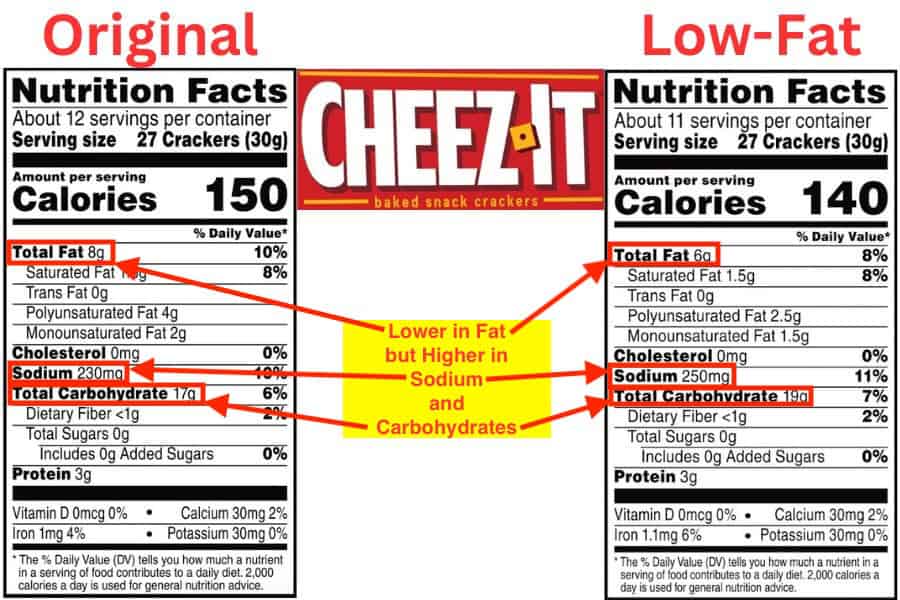
The Hidden Trade-Off: To compensate, manufacturers will add more sugar, salt, or artificial ingredients to try and keep the taste the same. So while the fat content may be lower, it is probably higher in calories, sugar, sodium, or some unhealthy additive.
However, some foods really do just remove the fat without any funny business, but unfortunately at the expense of the flavor. Such as fat-free cheese. Bleh!
2. “Reduced Sodium“
What It Means: Reduced-sodium means the product contains at least 25% less sodium than the regular version of that product.
The Hidden Trade-Off: Even some reduced-sodium products are still pretty high in sodium, especially compared to whole, unprocessed foods. Like low-fat products, manufacturers might add flavor enhancers to maintain the taste.
3. Sugar-Free & “No Added Sugar”
What It Means: “Sugar-free” means the product contains less than 0.5 grams of sugar per serving while “no added sugar” means no extra sugar or sugar-containing ingredients were added during processing.
The Hidden Trade-Off: In place of sugar, sugar alcohols are commonly used, which replace the sweetness of the sugar, but at a cost. Studies have linked erythritol and similar sugar alcohols to an increased risk of blood clot formation, which can lead to stroke and heart attack.
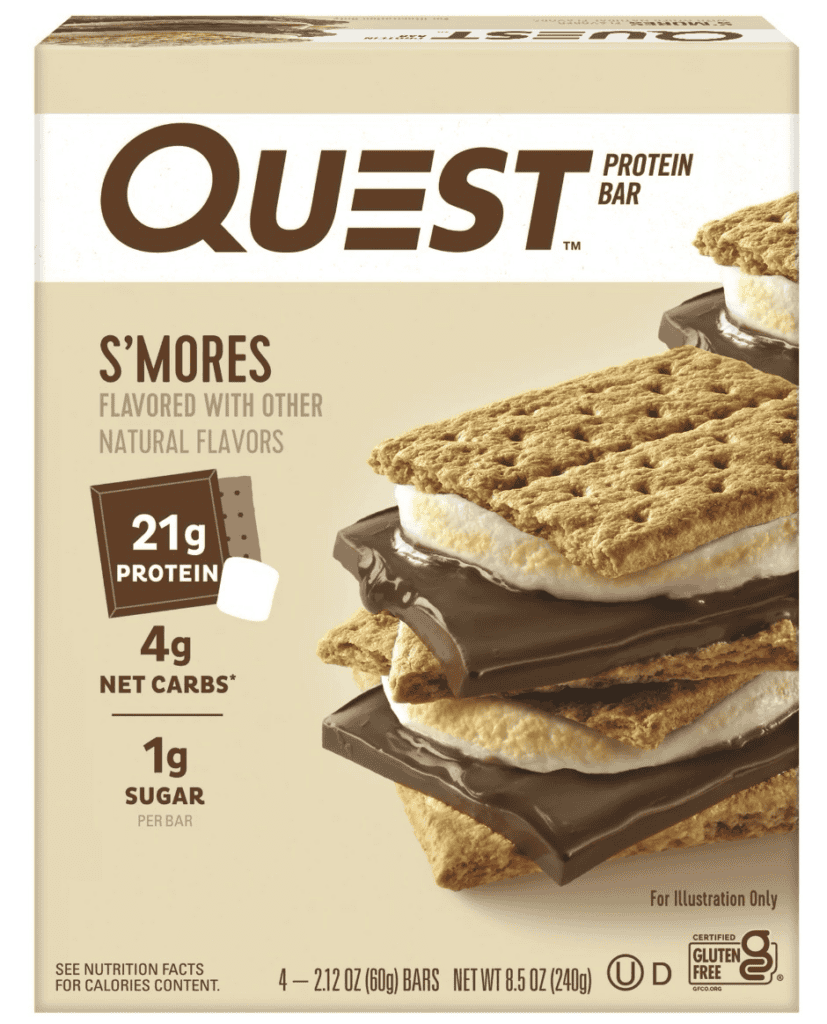

I always recommend avoiding these “sugar-free” options that contain sugar alcohols. To avoid them, look for ingredients that end with -ol.
Here are the most common sugar alcohols used:
- Sorbitol
- Xylitol
- Maltitol
- Erythritol
- Mannitol
- Isomalt
- Lactitol
Practical Tips for Avoiding Unhealthy Foods
Here is what it comes down to with ingredient lists and choosing healthy foods:
The less ingredients, the better.
Let’s use almonds as one last example:


The first option is the kind of products to look for- simple ingredients without extra, unhealthy ingredients like the second option.
Also, use the following rules to guide your choices:
- Opt for Fresh Foods: Fresh fruits, vegetables, and whole grains are naturally free from preservatives and flavor enhancers.
- Read Labels Carefully: Familiarize yourself with the common preservatives and flavor enhancers listed above, and choose products that are free from these additives when possible.
- Cook at Home: Preparing meals at home allows you to control the ingredients and avoid unnecessary additives.
- Choose Organic: Organic products are less likely to contain synthetic preservatives and flavor enhancers, though it’s still important to check labels.
The Bottom Line
You should now be well-equipped to make informed choices at the grocery store!
Let’s go over the key takeaways:
- Prioritize whole foods and shop the outside of the store, not the inside aisles.
- Always check serving sizes
- Look beyond the calorie count- check balance of fats, carbs, and proteins
- Avoid sugar alcohols and other hidden sugars
- Don’t be fooled by misleading health claims
Lastly, be kind to yourself and make one healthier choice than you made yesterday. Progress, not perfection!

